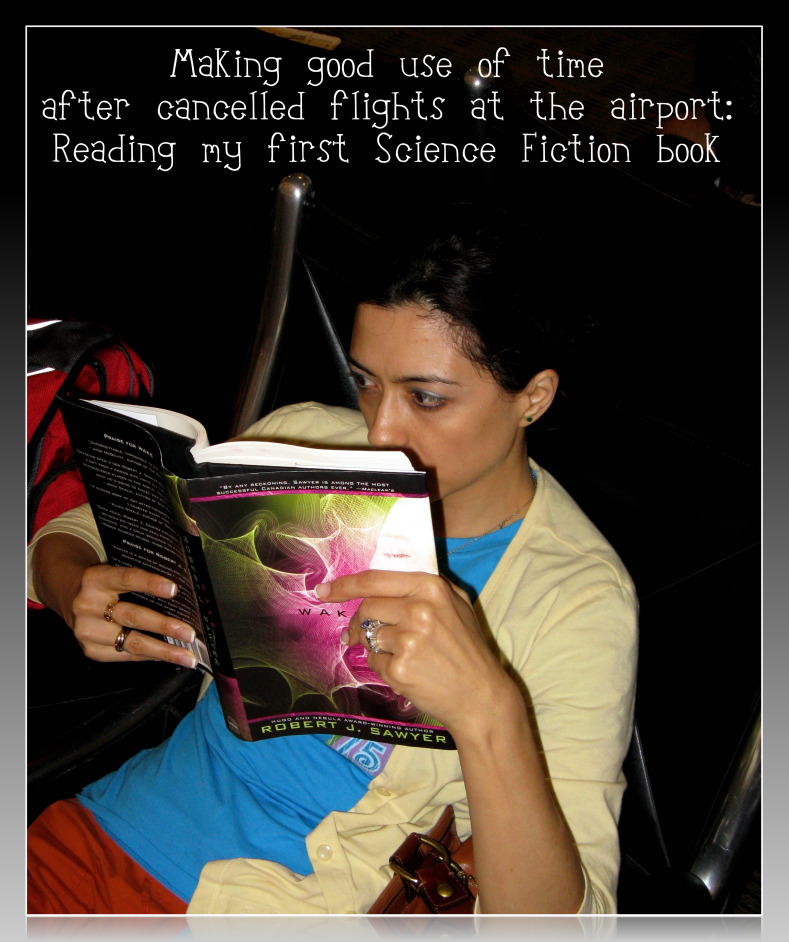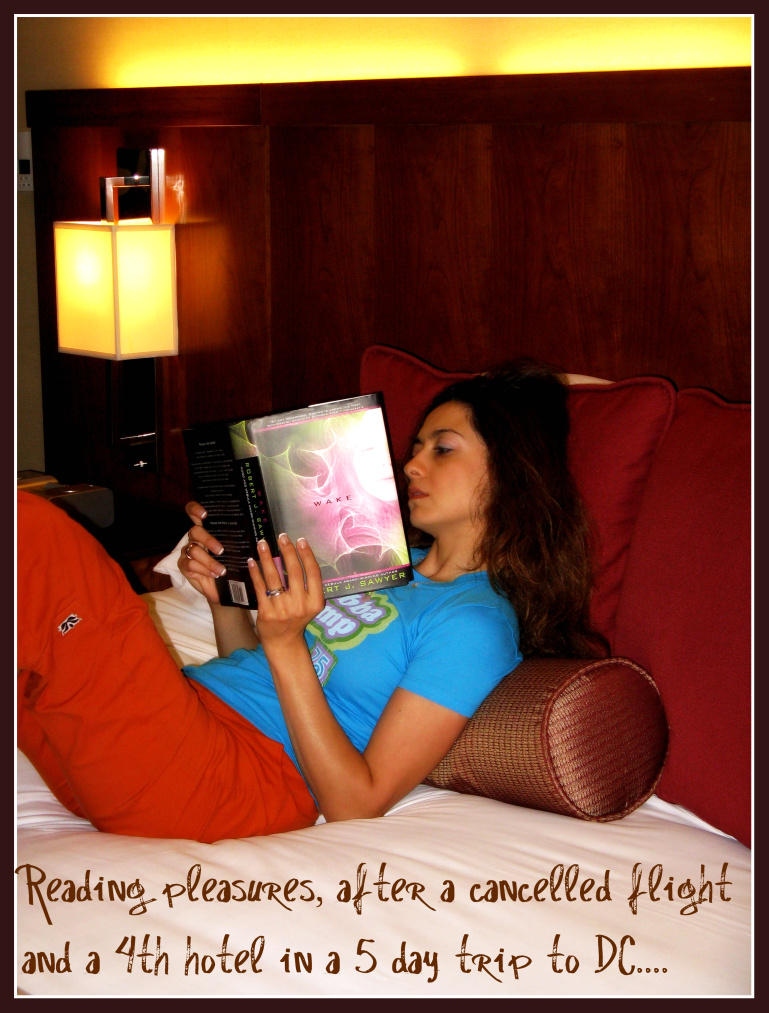 To be fortunate enough to have an infinite source of wisdom is rare, so I consider myself lucky. The source is my younger brother, Sina Bahram (I have been informed that he is now too old to be called my “little brother” but you know how that goes). Sina happens to be the smartest, sharpest person I know, and I thought I ran in smart circles. He is years and decades ahead of his peers, with a mind that impresses all around him, and a humility and generosity that is exceptional on all levels. He is all of this and much more while managing his life, his dreams, and his goals around a minor handicap and that is his lack of vision. His brilliant outlook on life continues to teach me the better ways of life, me who is 12 years his senior and his big sister.
To be fortunate enough to have an infinite source of wisdom is rare, so I consider myself lucky. The source is my younger brother, Sina Bahram (I have been informed that he is now too old to be called my “little brother” but you know how that goes). Sina happens to be the smartest, sharpest person I know, and I thought I ran in smart circles. He is years and decades ahead of his peers, with a mind that impresses all around him, and a humility and generosity that is exceptional on all levels. He is all of this and much more while managing his life, his dreams, and his goals around a minor handicap and that is his lack of vision. His brilliant outlook on life continues to teach me the better ways of life, me who is 12 years his senior and his big sister.
Robert J. Sawyer, the winner of all three of the world’s top science fiction awards (Hugo Award, Nebula Award and Aurora Awards) asked Sina to review the manuscript of his book, “Wake”, the first of Sawyer’s trilogy with “Watch” and “Wonder” on the horizon later. The main character in “Wake”, Caitlin, bears a striking resemblance to Sina’s thought-process, genius ways of assembling ideas and turning them into actions, with a most unique perspective on life to boot.
Through Caitlin who is a 15-year old teenager and blind since birth, I heard and felt much closer to my brother, and that is the top reason I loved Sawyer’s “Wake”. There are other reasons, but none so overwhelming when a fictional character creates bonds to someone so significant in your life. For this reason, and for the fact that I had an extremely hard time grasping the world of “Wake” as well as I had wished, this is a first book blog in which I will conduct an interview with a co-editor of the book, someone who knows the book, the author, and the story in impressive depth.
Warning: Our interview will include spoilers and would perhaps be most enjoyed by those who have read the book and are aware of the story!
Sina, thank you for doing the very first book interview on Prolific Living. I must tell you that I did not know I was reading a Science Fiction book until well into the book, my first instance was when Caitlin starts to see the WebSight through her Eyepod. Up to that point, it was just a really good book with several interesting plots. Now on to the interview:
Q: First, I was wondering what attracted you to the book so that you decided to get engaged in the reviewing process with Robert J. Sawyer?
A: There is a Blind Math mailing list for high school and college students who have trouble with mathematics and I do a lot of volunteering on that list. Sawyer hopped on that list, asking who has experience reflecting the traits of his main character: blind, teenage age, and familiar with technology. I emailed him back, and had already researched him and known him to be a famous author. We hit it off pretty well.
Q: What is the most appealing aspect of this book to you?
A: It’s pretty well-written and extremely well-researched, like when he mentions the bathrooms in Japan, and the details of automata data and 1970s computer research. He did all of this while making the story seem very plausible. Also I have extreme interest in Shannon information theory, as well as computer science of course. In addition, all the blindness related technology use was a major contributing factor.
Q: So the book’s title is “Wake”, I presume that is reference to the Caitlin awakening the “Phantom”, the entity that dubs itself the WebMind. Do you know what reason led James Sawyer to choose this title? I also noticed that the next 2 books in the trilogy are called “Watch” and “Wonder”, which flows beautifully but is there more depth to it?
A: In computer science, word puns, acronyms and play on words is a huge part of the culture. So the title Wake, also seen as WW:Wake, is a play on words for the World Wide Wake. Wake referencing the phantom or the entity waking up and coming to life in this story. Also notice, the 3 names all start with W and indicate a progression: Wake, Watch, Wonder, another play on words and a second potential acronym for WWW.
Q: At the beginning of the book, there are a few distinct sub-plots. There is the contained health disaster in China for which the government takes drastic clandestine measures, frustrating the blogger who can’t get online outside China. Then we have smart little Hobo, a hybrid of chimp-ape who is way off the charts in intelligence, and of course Caitlin. All of these subplots die away without any tie to Caitlin’s story. What was the point of those sub-plots in your opinion?
A: You are not the first to criticize the author for this. He certainly did this intentionally. Sawyer chose to keep the subplots, possibly to tease his readers into stretching the story for 3 books. In fact, Sawyer implemented nearly all of my suggestions with the exception of removing those sub-plots or giving them more weight.
Now it seems you may have missed one key significance: As a result of the China Firewall going up, the entity or the phantom actually experiences a “split”. In a way, they “lobotomize” the phantom, by separating him from his other half. That would be the key impact for China firewall in the early sub-plot. As for Hobo, might have to wait until you read book 2, where I hope he explains this further.

Q. Sawyer is a gifted writer no doubt, but for me, a difficult one to follow! His free-form phrases, as I call it, conversational fragments full of abstract thoughts and ideas which appear at the start of every chapter, and later on occupy even more space, seem to relate to no particular sub-plot. What am I to make of them?
A: Sawyer is actually brilliantly easy to follow. SciFi is usually a good medium for creative writing. Here, the author uses different writing styles for different perspectives. The words, the imagery, the tense, it is all very abstract and vague when written from Phantom’s perspective as opposed to when written observing Caitlin’s life. Naturally, towards the end and no earlier does it become clear that all of that was from the phantom’s perspective.
Q. Let’s talk about Caitlin. She is mature beyond her years in a fashion extremely similar to you. She sees more of the world without seeing. She has a grasp on what is important, and her perspective on life, her wisdom, her patience and her attitude are exemplary. How is it possible for her to achieve this? What do you think drives her with so much motivation to live this way? And do you see the resemblance to you as much as I see it.
A: My definition of maturity is simple: It is how you react when things don’t go your way. Caitlin is quite used to not having things go her way given her handicap. Kids with disabilities are usually more mature when that type of reaction has been cultivated in them so often at an early age. There are essentially 2 choices: 1) Feeling self-pity and misery for one’s situation, or 2) Feeling ambition and drive for one’s goals and not even acknowledging that the handicap is an obstacle. Then you put forth 3 times the effort and expect good results. It’s always Option 2 for Caitlin, and for me.
Q. Sawyer has an impressive grasp on computer technology. He can create brilliant visual effects around the massive terabytes of information transferred every millisecond. When Caitilin first realizes that she is looking at the Web using the Eyepod, she is intrigued and at times even satisfied enough to forget that the real purpose for the operation— that of giving her full vision back – had temporarily failed. Sawyer takes us through Shannon Entropy concept, which I touched on in my graduate program. He explained clearly to an average reader that this algorithm measures the properties of data such as its complexity and level of intelligence. Now, can you explain the other concept, Automata and comment on how it weaves into the story?
A: Cellular automata is a fascinating field. Back in 1970, John Conway popularized a 0-player game known as The Game of Life. It’s called 0-player because you just cede the game with some initial values, and then let it carry on, iteratively, forever. Basically, the concept goes like this. A cellular automata is a grid. Think of it like a chess board or any other square with compartments in it. Each of these compartments or squares is known as a cell. Now, there are four basic rules that the game follows.
1. Any live cell with fewer than 2 live neighbors dies, as if in under-population.
2. Any live cell with more than 3 live neighbors dies, as if by overcrowding.
3. Any live cell with 2 or 3 live neighbors lives on to the next generation.
4. Any dead cell with exactly 3 live neighbors becomes a live cell.
So you just pick some values to start off with, and then you just keep running these rules, over and over again, and watch what happens. So starting out with some values, applying these rules we get a pattern, and we apply the rules again and a new pattern emerges. We repeat the cycle and suddenly you realize that you have a seemingly intelligent and very beautiful moving shape, one shape dissolves into another, like the gliders or flyers that Sawyer mentions. It gives us the illusion of something intelligent going on.
Fascinating, really. Now insofar as the novel goes, Caitilin sees this “chaos”, a cluster of activity. They deduce in the novel that what she sees must be lost or discarded data packets running around in the web. What I assume here is that phantom looks like Automata to Caitlin and over the course of the book, the entity’s topology changes because it is growing more intelligent. Therefore, the automata evolves in colors, shapes, intensity, and motion.
Reading is the best pastime for an active mind! If you like to see the other book reviews, check the index of In Print.
Q. Now last few chapters, when Caitlin has experienced the other entity she calls the “Phantom” are entirely too abstract. Even so, I particularly enjoyed how the Shannon Entropy results that she would run on the Phantom would increase as it was devouring the information in the web. So my question is this: If the Phantom is the Web, hence the Webmind name it gives itself, then how come it needed to re-learn (or learn for first time it seems) all the information out there in the web? If so, is the Phantom perhaps more a carrier of this information without being able to decipher it — at the beginning — and then at the end, it is both the carrier and decoder if you will of all the information, hence the intelligence? How should we think of this phantom? Is it a ghost hovering around Caitlin, or is it the invisible mind in the web that is observing our every move (spooky).
A: Let me ask you something: Can you right now explain to me how RNA transcription or translation works? (No). But it is happening in your body constantly. Can you explain what is happening in your body in the biochemical way? How does your heart work? Same for this. Sure, the phantom is comprised of information but it has no idea what the information is. Just like we are comprised of proteins, fat molecules and more but we don’t know it until we discover it. Similarly, computers are comprised of bits and bytes, software and hardware; however, I’ve yet to meet a computer that is a better programmer than the most inept human, given an arbitrary problem.
Q. Caitlin’s references to Helen Keller’s life were poignant and relevant. The best passage was from pg. 277, when Helen first learns about water by Ann Sullivan running water through her hands. Caitlin remembers this because she was starting to feel the presence of the “Phantom” in her room as she was going through her spelling software. She wanted to awaken the soul of this “Phantom” — just as for Helen Keller, as she wrote in her journal, “That living word (water) awakened my soul, gave it light, hope, joy and set it free!” Caitlin then realizes she has to set the phantom free and gets to work. I find it interesting that even though there is no merit to the story in reality, and that we are following a fantasy, that the author is still very careful in slowly introducing new concepts, without overwhelming the reader, and soon they add up to larger phenomena, but the reader can follow and still keep footing with reality. What do you think?
A: If you have something that has the potential to learn and to be educated, you can teach it. Period. Hellen Keller is that association of learning for Caitlin. She is the concept of learning for Caitlin who says that she wants to awaken the soul of the phantom in a metaphorical sense.

Q: Thank you. Sina. Any closing thoughts for the fans, current or future, of Robert J. Sawyer or any other readers? And hey, are you going to review the next manuscripts too or do you think Sawyer now has the hang of it pretty well? Just kidding!
A: Well, I doubt I’ll review the second and third novels, as they’ll most likely not involve too much blindness related goings on; however, I’m of course open to offering anything I can, if he happens to ask. As far as closing thoughts for the readers, I would just like to say thank you for reading this whole interview process and all of Farnoosh’s posts. We, so called little brothers, always love to see our old sisters (just kidding), excel at any kind of project, and I’ve loved seeing ProlificLiving grow from an idea to blossoming into the full blog it is today. I also would like to encourage you, Farnoosh, to read another science fiction book, or ten. It sounds like this is an area you might enjoy if we sci-fi fans can get you hooked. Thank you so much for having me.
 I am Farnoosh, the founder of Prolific Living. So glad you are here. My mission is to empower you to unblock your creative genius to live your dream life.
I am Farnoosh, the founder of Prolific Living. So glad you are here. My mission is to empower you to unblock your creative genius to live your dream life.